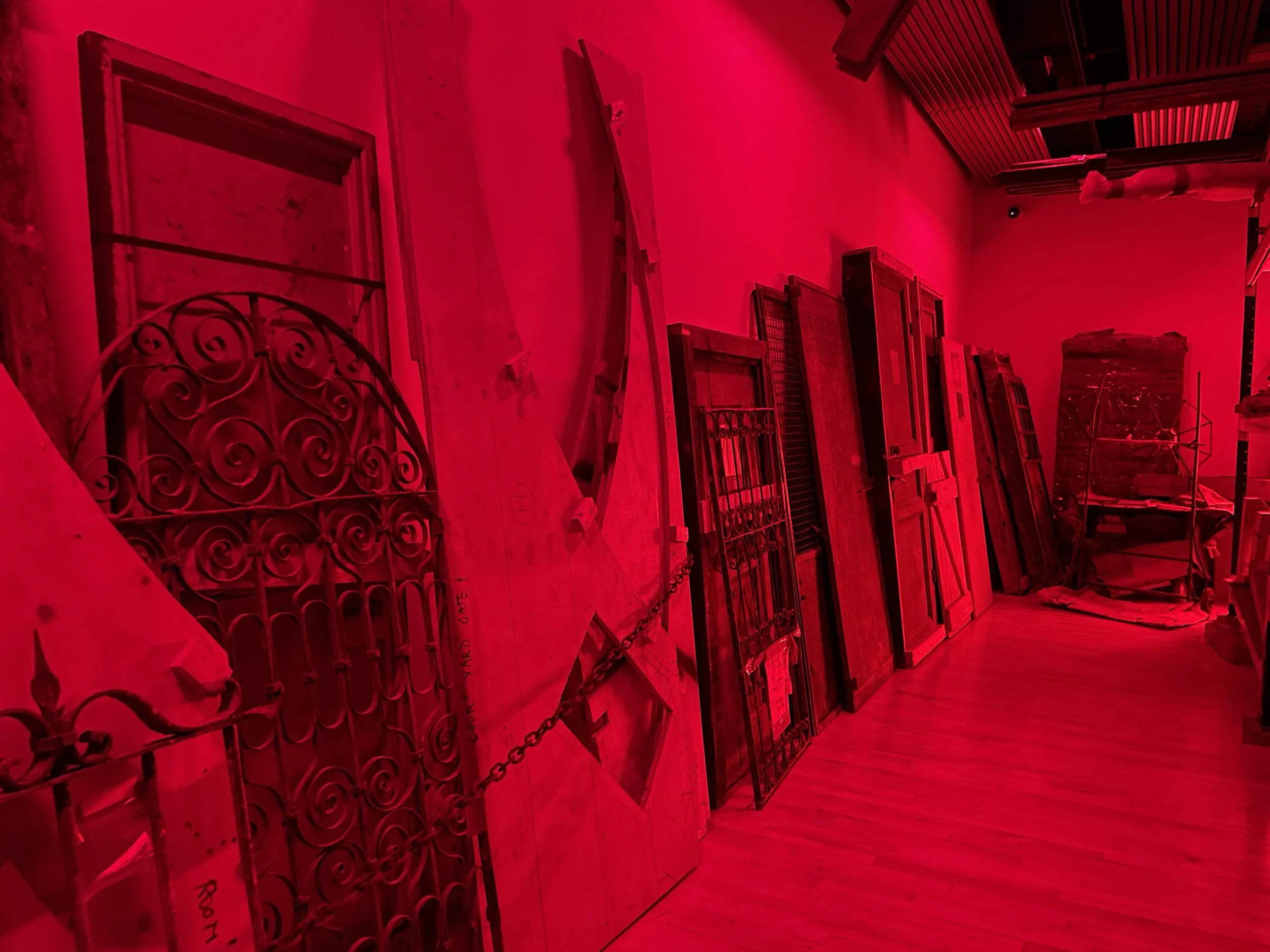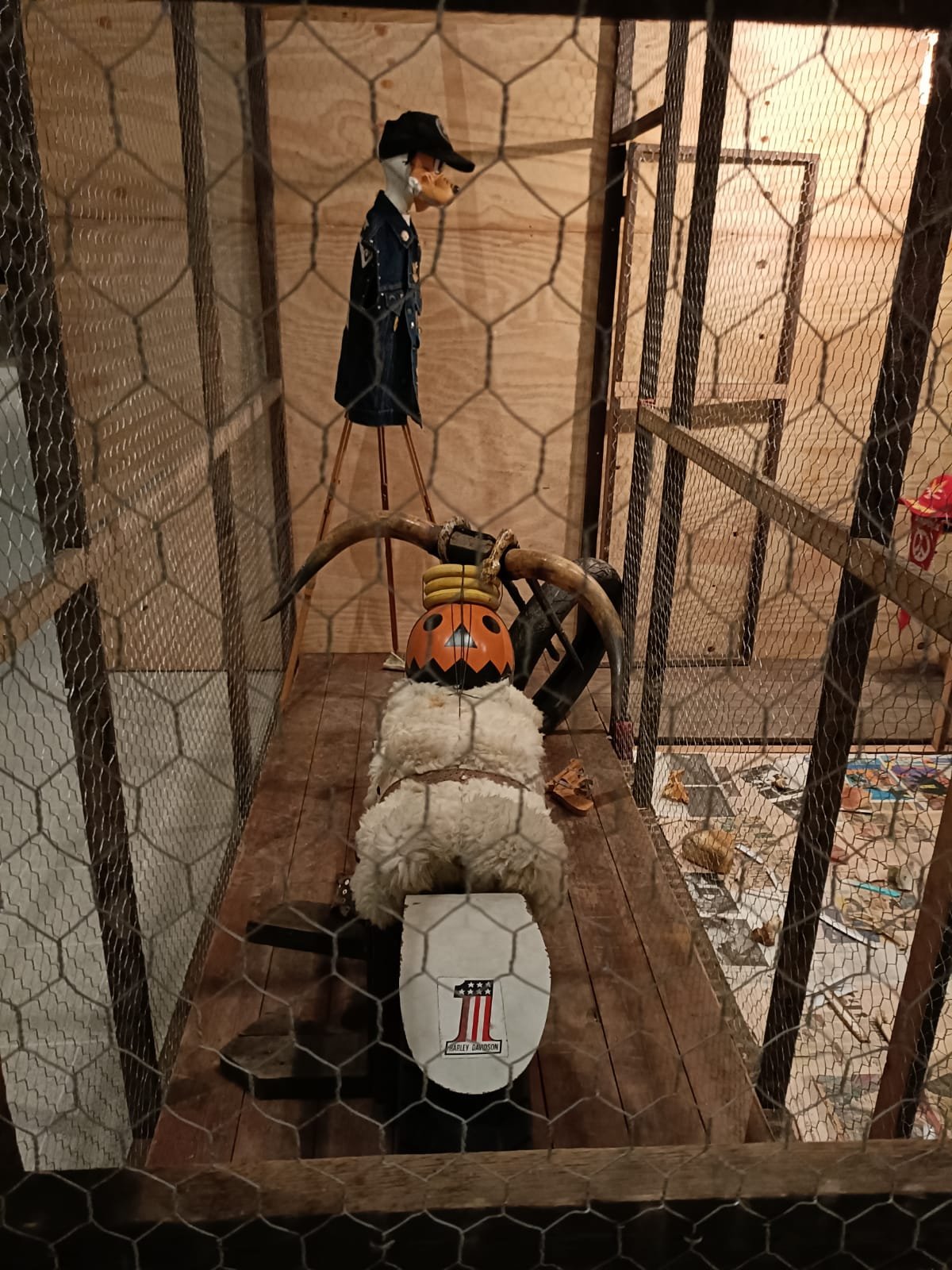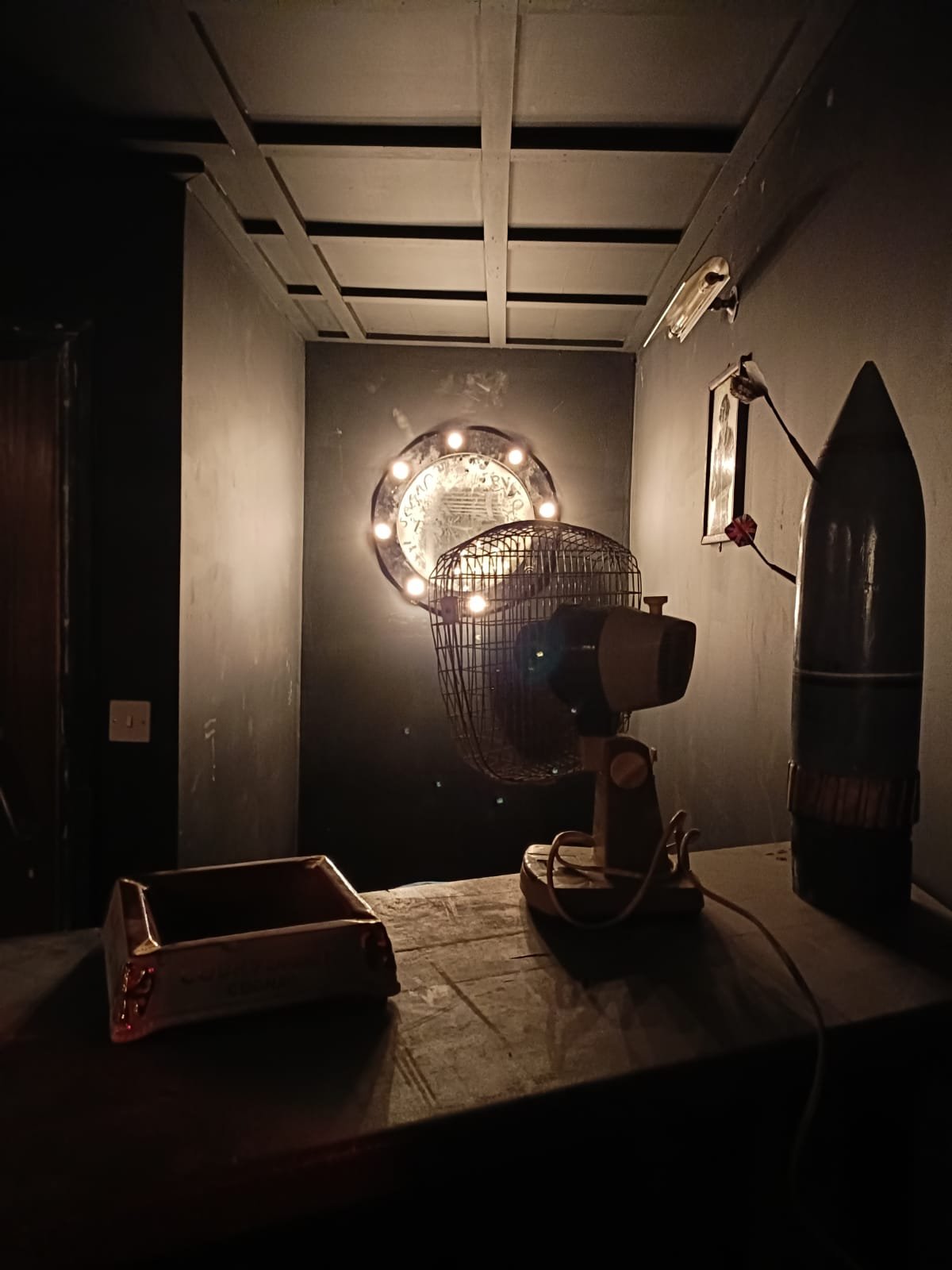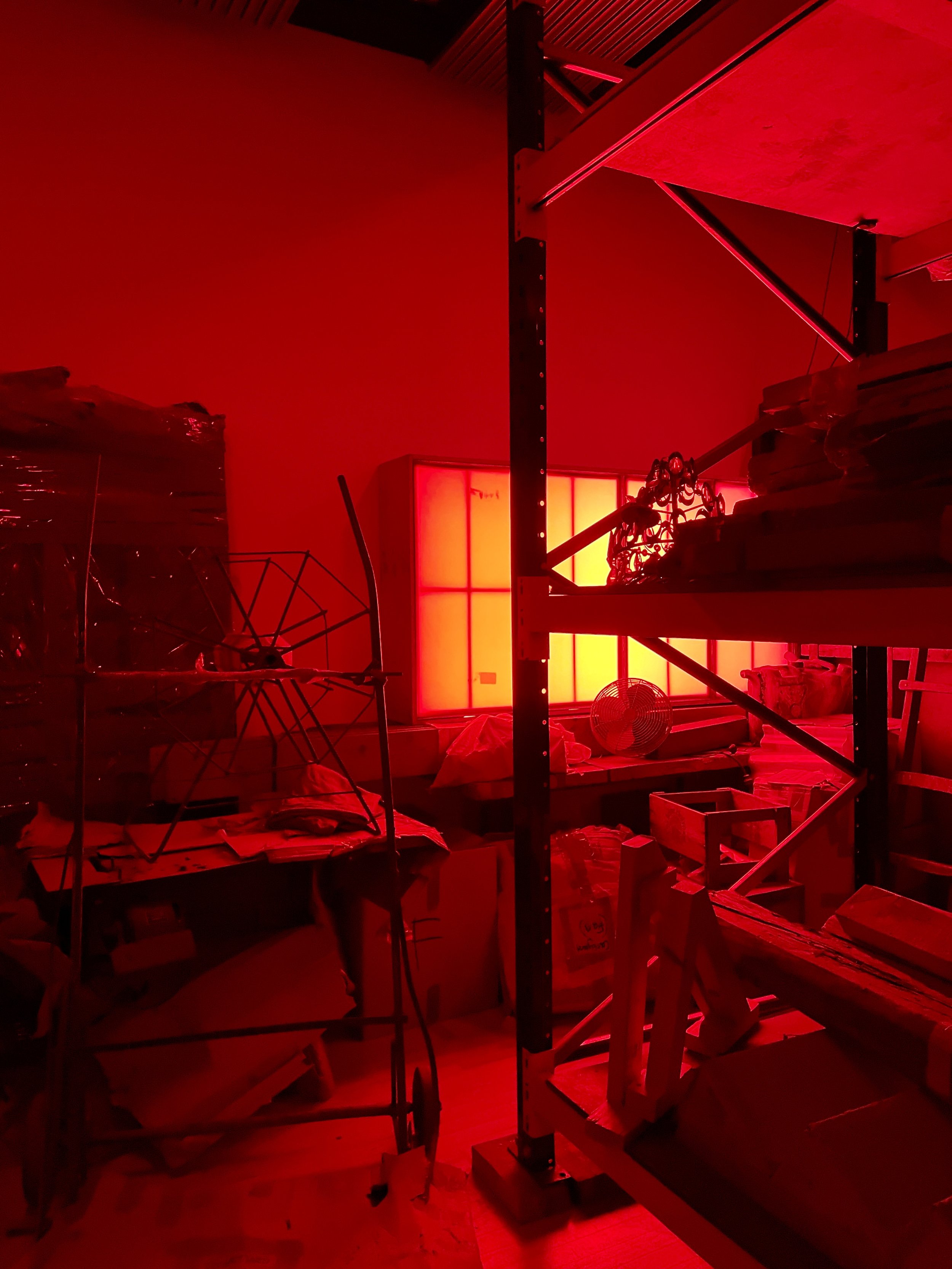It is with great excitement that we can now add exhibition reviews to the site, due to our new venture covering art exhibitions and openings around the world…
Mike Nelson: Extinction Beckons
22 February - 7 May 2023
Born in Loughborough (UK) in 1967, Mike Nelson lives and works in London. Nelson represented Britain at the Venice Biennale in 2011 and has twice been nominated for the Turner Prize (2001; 2007).
Mike Nelson is represented by 303 Gallery, New York; Galleria Franco Noero, Turin; Matt’s Gallery, London; and neugerriemschneider, Berlin.
‘My intent has always been to make immersive works. They should have a narrative, a spatial aspect, but also a psychological effect on the senses: you’re seeing and feeling one thing whilst your brain is trying to override this and tell you something else…’ Mike Nelson
By Nichola Rodgers
Mike Nelson has always been an artist whose work I have admired and be inspired by in my own practice, so you can imagine the excitement when we were invited to be part of the press for his new exhibition opening at the Hayward Gallery.
Called Extinction Beckons – this title starts you on a journey of what could be expected, and it’s not quite what you think. The structures of Nelson’s installations or environments are a must-see, walking through a dystopian wilderness, a film set, or like being lost in a book, creating Myth through Matter…
This exhibition is completely new, and somewhat familiar, as though you are revisiting a place you thought you knew with different eyes you see different things. This is what has always intrigued me about this type of installation art, it is an experience that can only be seen when you are within the work, adding to its narrative.
Art exhibitions of this kind that use detritus may help draw attention to the excess of consumer consumption, and narrow the gap between the worthless and valuable that Scanlan talks about in ‘On Garbage’ - “our distance and separation from rubbish is what makes culture possible- separating the valuable from the worthless”
That divide becomes even more blurred, as artists like Mike Nelson create installations from these discarded objects, forcing us to look at these once worthless things and reintroduce them into our present being to unintentionally give them value again.
The concept of elevating a found object to artistic status has a long history, where artists create work that is more like a memory, or a twist on a dystopian view of the traditional “cabinets of curiosities,” things collected and displayed from their travels. These discarded objects have a history, which may or may not be relevant to the work, but what is relevant is what the viewer brings through their own memories. Through the reuse of this found matter, Nelson creates other worlds and artworks that stand in a curious no-man’s land between fiction and documentary.
Extinction Beckons covers a vast area sprawling out through the whole gallery. It’s not a linear didactic show to follow, more of a web of tableau to be immersed in. taking influence from literature, particularly William Burroughs, lost belief systems, class, society, war, and speculative fiction, through a montage of fragmented settings.
At first, glances as you step into the exhibition you might think Mike has created an environment of ordered disaster, or detritus, but as you walk through the first room hazed with a red glow light and shelves piled high on either side with discarded objects the feeling of disaster subsides and its as though you are now in a waiting room or some celestial place with these objects you become part of that waiting, either to be assembled or disassembled into a new story with new meaning.
This idea of unknown objects and what they might or could mean informs a great deal of Nelson’s work. Like Rauschenberg Nelson is showing us the everyday object in a new surreal way, this works well, as he is also exploring the fragility of existence, as his work is void of the figure until the viewer is present thus becoming a part of the work.
It is when you leave this room that you follow the journey of these pieces as they unfold before you into the space.
As you enter the first door, you become part of the work instantly, thinking you recognise what you see but with an unsettled feeling of displacement, as though dreaming-like you walk through many heavy, cumbersome doors, jolting you with the loud sound as they shut out one scene to reveal another new setting of familiar otherness. Each room is set out with discarded pieces, assembled with you the viewer creating its intentions.
From the maze of rooms that evolve as you move, you are taken to a solid sculpture piece, called Untitled( Public sculpture for a redundant space) this concrete and rubble-filled sleeping bag an item of survival is placed in an unused corner next to eroded wooden planks that happen to be laid as a cross, is this a nod to society need to build rather than nurture or is it a nod to religion being just as destructive as politics?
As you continue this journey you come across another space that is engulfed by Nelson’s reimagining of objects into a dystopian desolate wasteland, Tripple Bluff Canyon (the woodshed) is a submerged building, waste rubber tires, and a sand dune piled high, encasing these objects together, as you walk through beneath this sand you are confronted with a dark room light up red with exposed photos as if you have just stumbled into a secret lab…
The tools that Mike uses to create these works also become part of the adventure as you come across The Asset Strippers these towering pieces of equipment that look like they have a life of their own and could have just walked off the workbench you see before them.
The final piece in the disjointed yet connected dreamlike narrative is the amalgamation of several works created with various materials. Here you are on the outside looking in. This caged environment of building rubble, re-bar, wooden structures, projections, decapitated concreate heads formed from various clown masks, and rooms without access, sets an unnerving yet darkly humours scene, that kind of nods to a distorted view of where our heads as humans could be at now, could we be viewing a future predicted or a past remembered?
Mike Nelson critiques subjectivity by suggesting it is just fiction with very little to do with the objects used apart from to tell a story, his work is vast and drawn out much like a novel, and isn’t complete without the viewer connecting with the work recognizing items and spaces. The work takes the viewer on a journey and directs them off their predictable paths and jolts them into a new sense of awareness. The way the work is shown is just as important as the objects themselves, focusing on the experience of the work, not just the aesthetics.
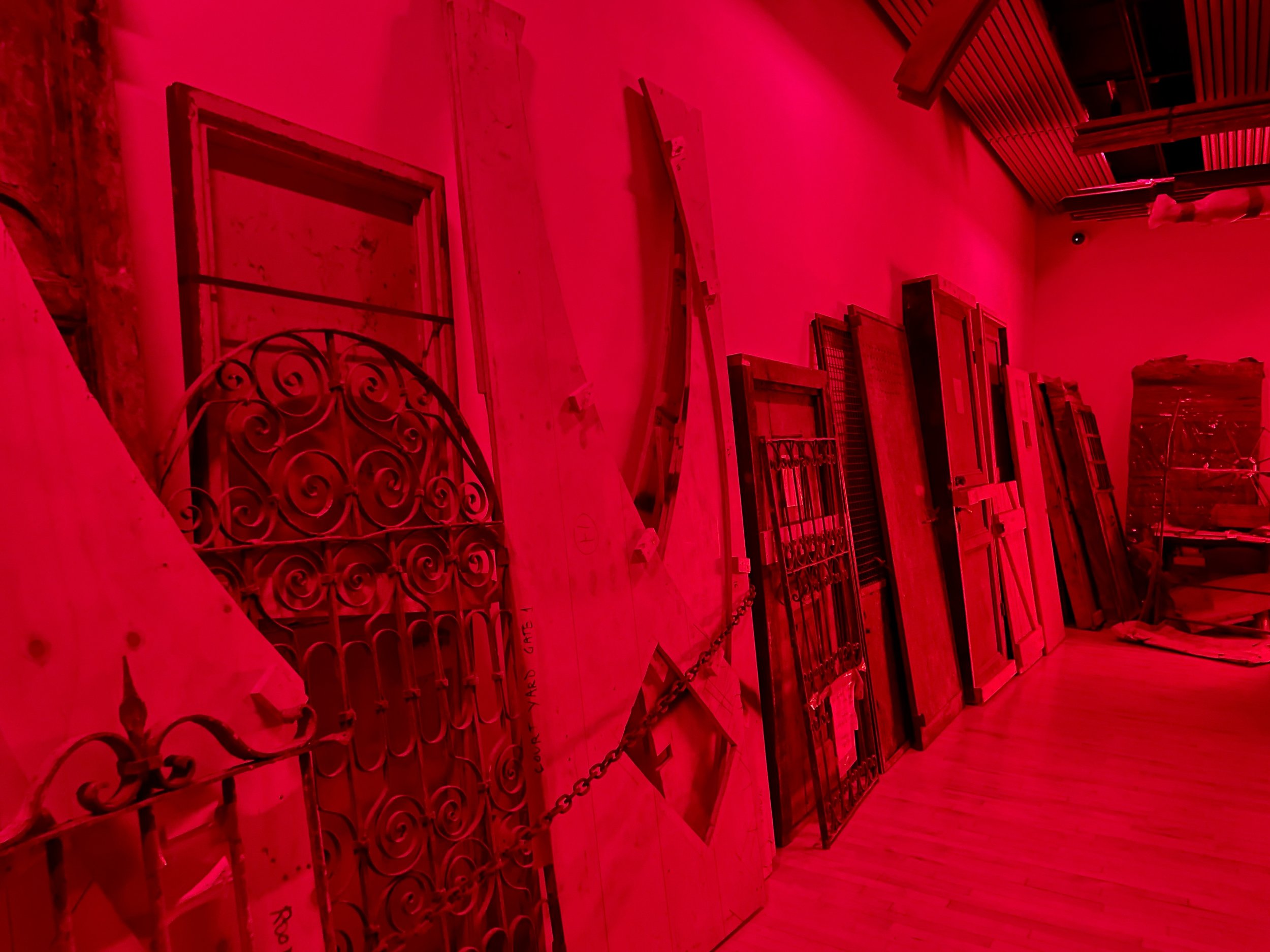
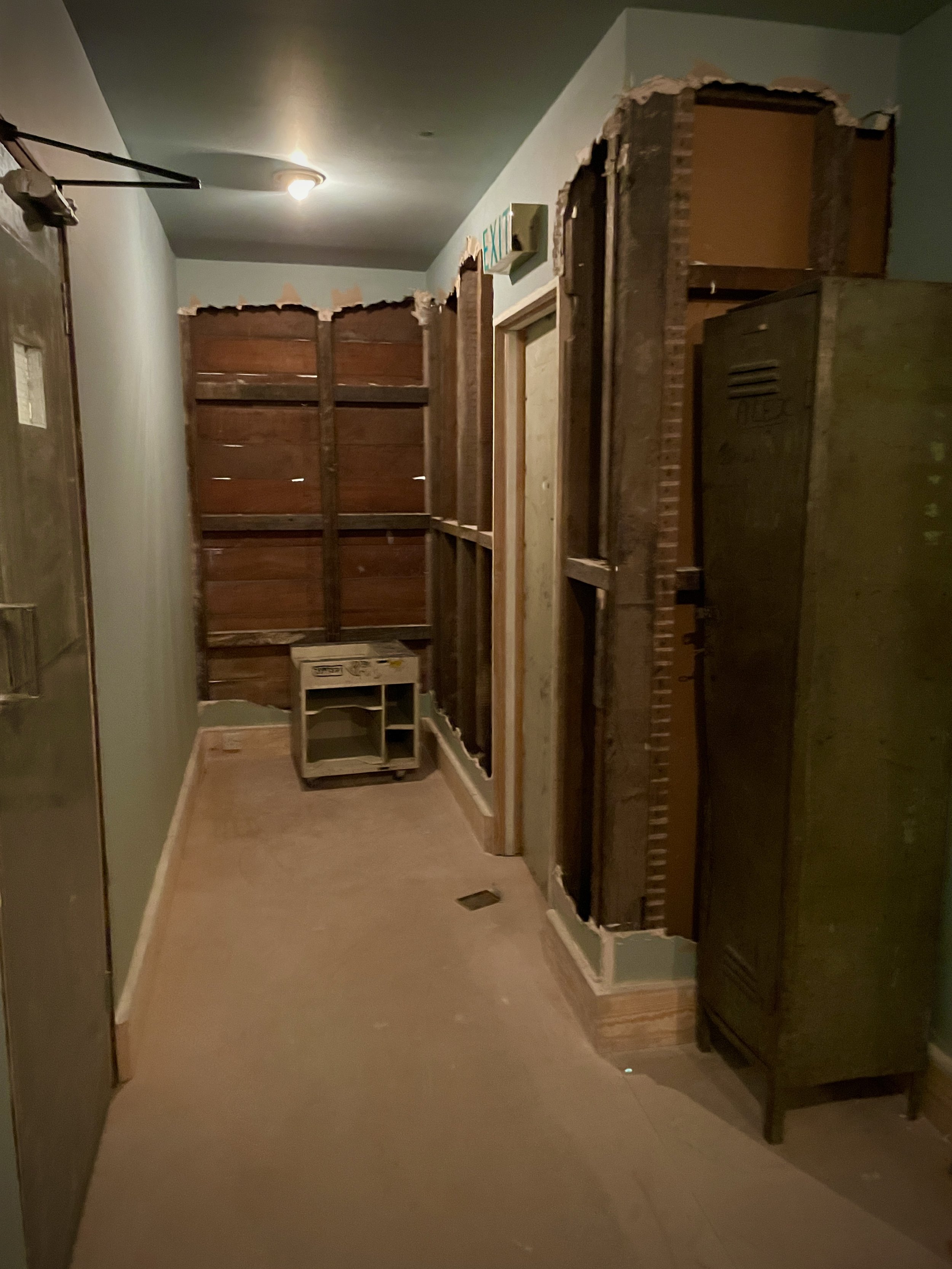

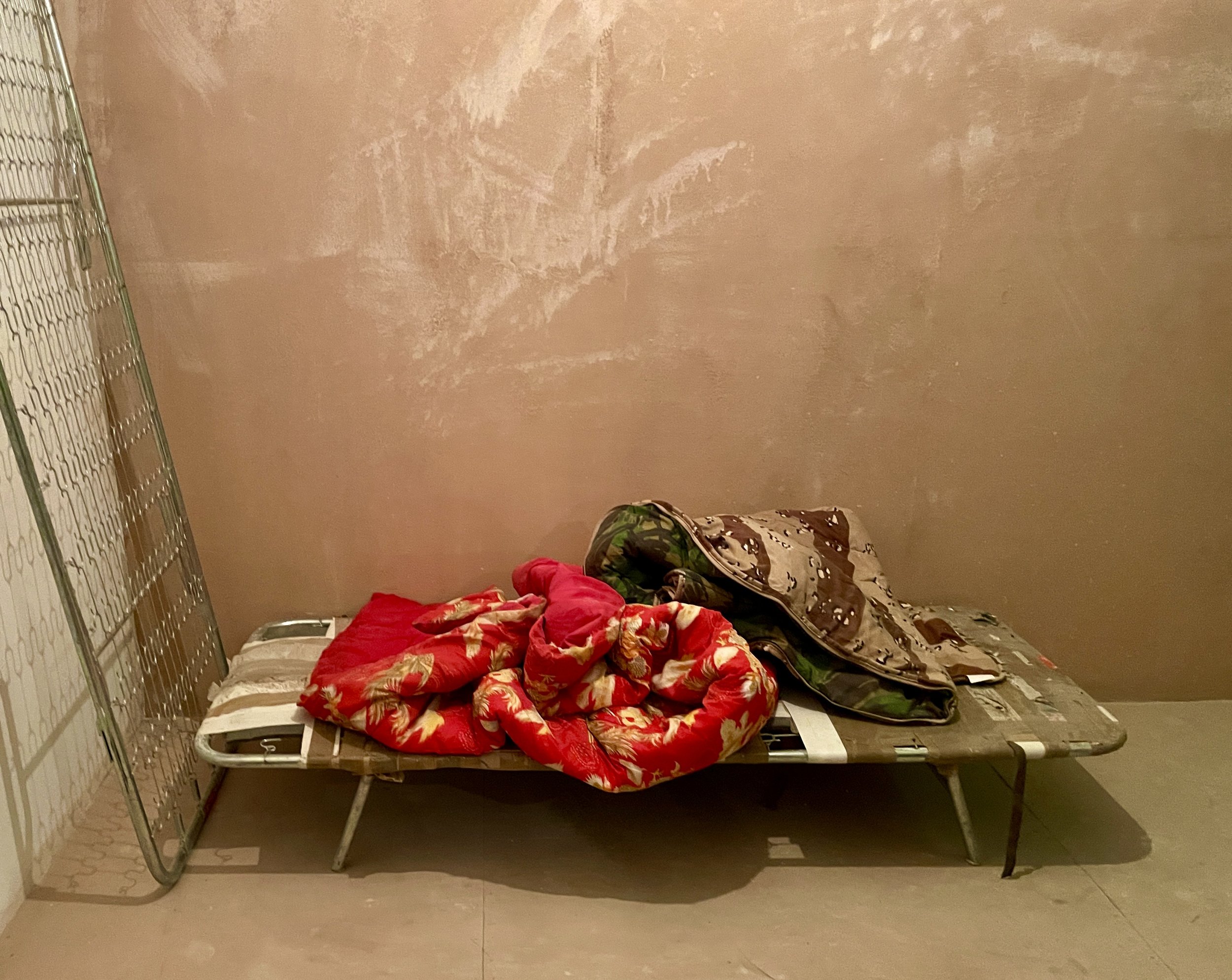
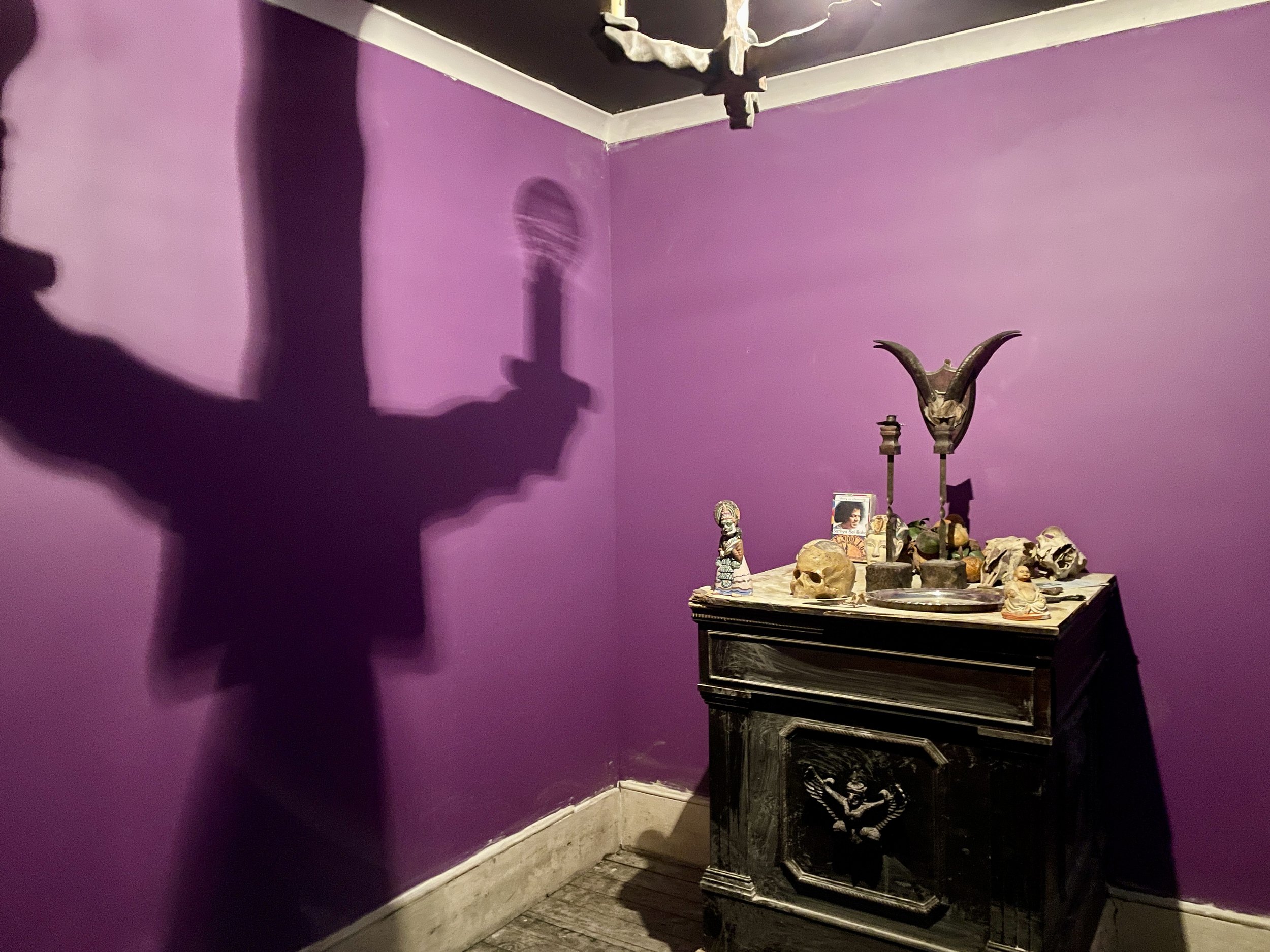

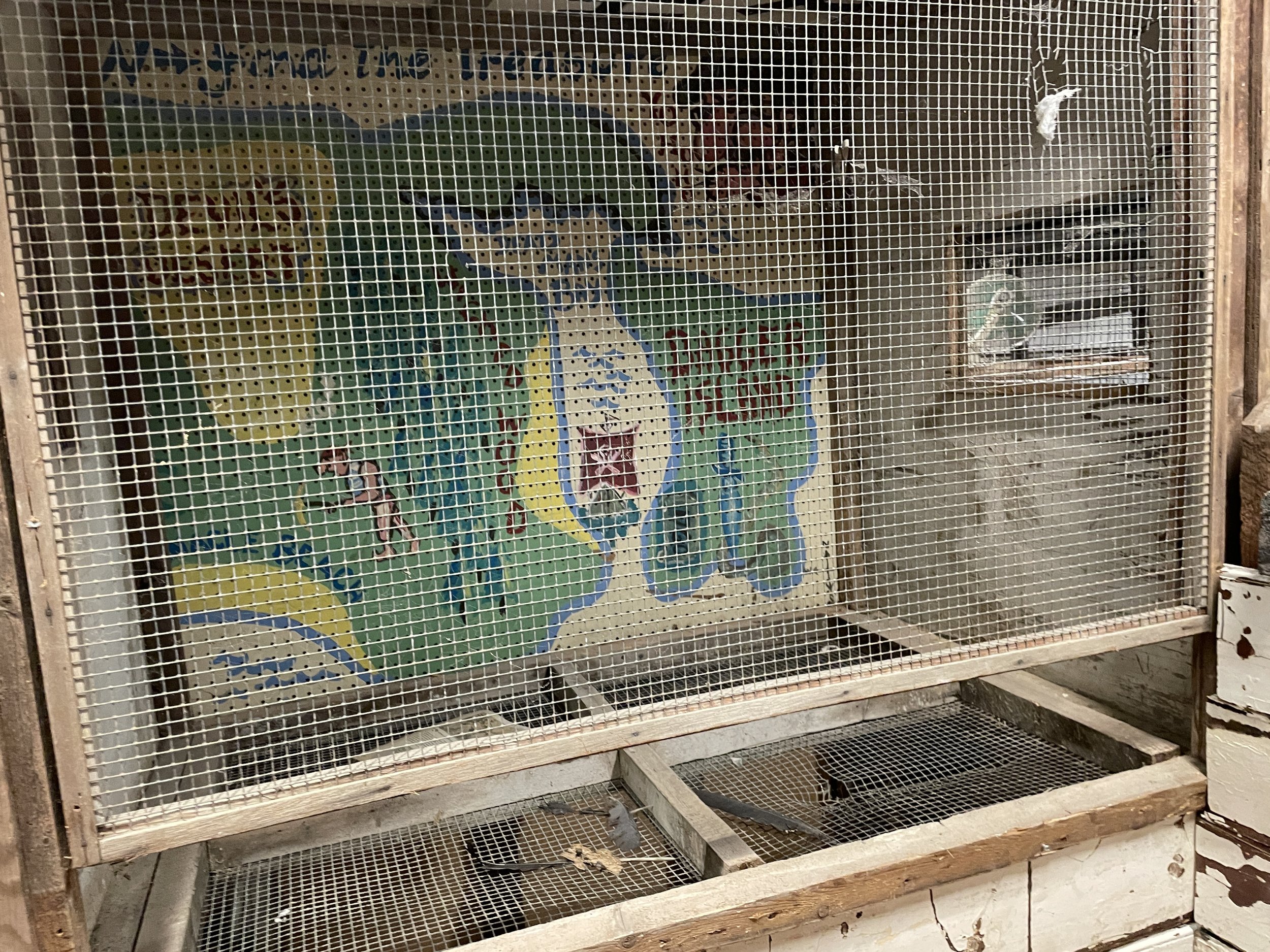
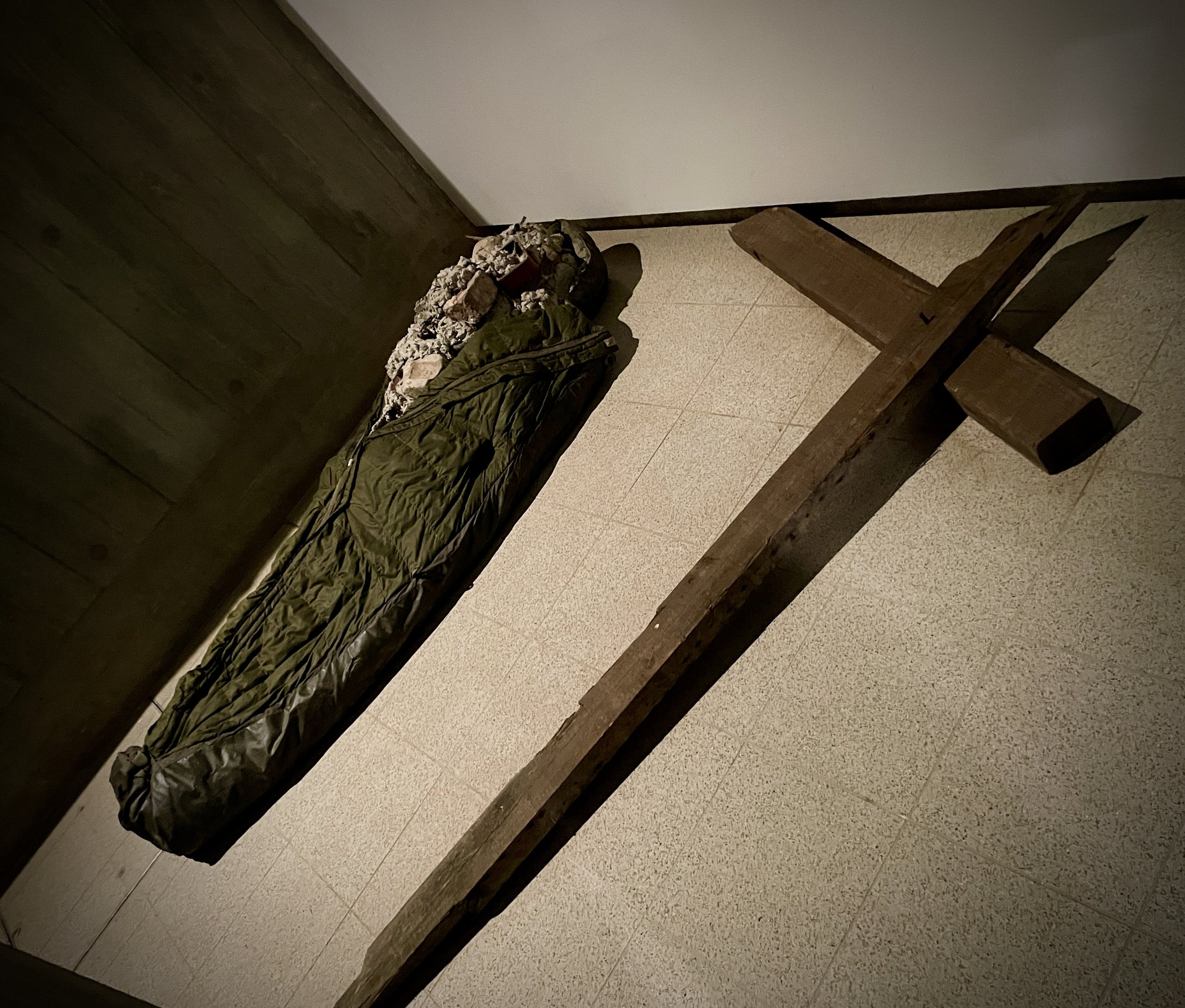
By Jenna Fox
While waiting for the press event to commence we overheard Mike Nelson being interviewed by a journalist who asked about the “chaos of the materials”, but the show is anything but chaotic.
It is planned, methodically envisioned, constructed, and reconstructed with everything in its place. Using past installations Nelson reconfigured and amalgamated them to create the show, his largest to date.
For four months in a warehouse in Kent 30 people assembled and built the works which were shipped to Hayward for another four weeks of reconstruction, working six or seven days a week to complete. The sheer mass of mater and scale is impressive and must have been a logistical challenge.
The show opens with a red-lit room I, IMPOSTER (2011). It is full of industrial racking and is the start and the end of the installation pieces journey – as this is how materials are stored once deconstructed and waiting to the reimagined and repurposed. As a collector and sculptor, it would be my dream to have such a storage bank. It was a part archive and part magical repository of materials.
Moving into the huge exhibition space we entered a labyrinth of corridors and doors with small rooms THE DELIVERENCE AND THE PATIENCE (2001). This is created using salvaged doors, skirting, architraves, and paraphernalia of past times. It was dimly lit but full of possibilities.
For me, it felt comforting and oddly womb-like as the smells of old plaster and dust reminded me of past refurbishments in Victorian houses. The rooms had loose themes, one with prayer mats and a bookrest, one with ships, an office, a bar … or rooms with a purpose that the viewer chose to give it.
It reminded me of Gregor Schneider’s house and unsettling spaces and how the viewer becomes part of a performance as they move through the spaces. The viewer interacts with the piece and makes the maze come to life.
It is a mind map, a nod to video games, post-apocalyptic, an archive, a museum, a memory and none of these.
Nelson combined installations to create TRIPLE BLUFF CANYON (THE WOODSHED) 2004. Using sand and tyres sourced from the M25, it’s evocative of war and the traces left behind. To the side is a narrow corridor that leads to I, IMPOSTER (THE DARKROOM) (2011) which had a bunker-like feel and a passing of nostalgia for the android processing of film development. Capturing memories of the show.
THE ASSET STRIPPERS (2019), with the works, stand-alone and sculptural. They stand as a reminder and commemoration of the demise of British industry in the 1980s. Nelson explained that he has asset stripped his own store of materials to revise and repurpose works for the show.
We entered a gallery with a huge installation STUDIO APPARATUS for Kunsthalle Münster (2014). This consisted of metal grids and bars used in construction to strengthen concrete and from these cast concrete heads were hung. Nelson cast the heads in his studio using rubber masques, one of which hangs amid the installation a burst of colour amongst the industrial colours of the rest of the work that draws the viewer in and is a clue to how the heads were created.
There could be many readings for this installation – that we are confined by the matrix, heavy in head and with a dearth of fun or we need to strip back the construction of our lives. And this is the joy of the show, that it engages the viewer to create their own fantasy and narrative.
Next a series of cages, THE AMNESIACS (1996 – ONGOING) which holds sculptures and sets. Some eluded to war and battles and it is unclear if the cages are to imprison or preserve or archive. My favourite combination piece was a motorbike with horns and a tyre which was reminiscent of Rauschenberg’s MONOGRAM (1955 – 1959) but perhaps that is just how my mind works.
Finally, there is a room TRIPLE BLUFF CANYON (the projection room) (2004) built-in what looks like crate packaging with sounds that have a conspiratorial ethos.
Inside it could be a lounge from a 1930s house, but it is full of equipment and resembles a war room. It is too full to be used as a family room as it is full of artefacts that are juxta positioned and form conversations.
The show is a wonder. Of logistics and creativity. Not a retrospective but a reworking and reimagining of older works. Nelson plays with the materials and with us. It’s dark and it questions if there is hope.
Yet, there are nuances of humour and the possibilities of new stories and adventures to come.
As we listened to Mike talk about the Exhibition, we see there is a need for art of this kind, not art that is forever there but work that disappears from sight, deconstructed never to be seen the same twice, drawing our attention to it knowing we will never be part of it again creates memories in the viewer that evolve on their own like Chinese whispers keeping these piece evolving and alive on another level…
Exhibition Listing Information:
Mike Nelson: Extinction Beckons
22 February - 7 May 2023
Hayward Gallery, Southbank Centre, Belvedere Road, London SE1 8XX Full price standard: £15
Concessions available & Southbank Centre Members go free.
Link to Mike Nelson: Extinction Beckons web page HERE
The Hayward Gallery opening times: Wed – Fri, 10am – 6pm
Sat, 10am – 8pm
Sun, 10am – 6pm
Further information:
Twitter: @haywardgallery
Instagram: @hayward.gallery
Facebook: www.facebook.com/haywardgallery/
Public Programme Information:
Mike Nelson in Conversation with Ralph Rugoff
Thursday 9 March, 7pm
Level 5 Function Room, Royal Festival Hall
Hear the artist discuss his work and our current Hayward Gallery exhibition, Mike Nelson: Extinction Beckons, with the gallery’s Director, Ralph Rugoff.

